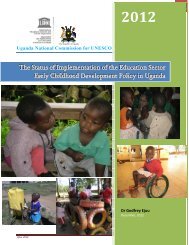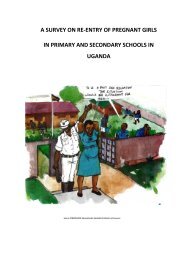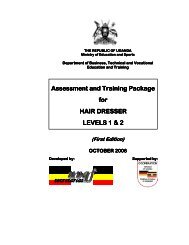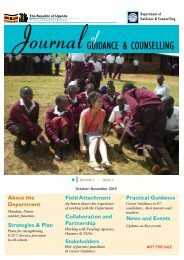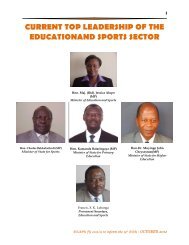Download Pdf - Ministry of Education and Sports
Download Pdf - Ministry of Education and Sports
Download Pdf - Ministry of Education and Sports
Create successful ePaper yourself
Turn your PDF publications into a flip-book with our unique Google optimized e-Paper software.
percentage point improvement <strong>of</strong> 6.3 % (3.1% male; 9.5% female). It is important to note that the<br />
literacy rate among females improved at a higher rate compared to that <strong>of</strong> males.<br />
The improvement in literacy is attributed to a number <strong>of</strong> government programs among which<br />
includes the Functional Adult Literacy (FAL) program. The enrolment <strong>of</strong> men <strong>and</strong> women in the<br />
Functional Adult Literacy (FAL) program has progressively increased as shown in Table 8. It is<br />
observed that there are more women enrolled into the FAL program than men. Currently, there are<br />
434,663 with 108,943 males <strong>and</strong> 325,721 females into the Functional Adult Literacy program. Although<br />
it proportionately appears that the percentage increase in male enrolment is higher than that <strong>of</strong><br />
women, in nominal terms, women are far more than men in the FAL program as presented in Table<br />
4.31.<br />
Table 4.31: Enrolment in Functional Adult Literacy (FAL)<br />
Year Male Female Total<br />
2000 27,786 86,085 113,871<br />
2001 30,658 118,351 149,009<br />
2002 86,293 271,971 358,264<br />
2003 89,119 323,579 412,698<br />
2004 108,943 325,721 434,663<br />
2006 85,447 215,244 300,691<br />
2007 92,879 212,648 305,526<br />
2008 101,919 226,917 328,836<br />
2009 107,947 220,194 328,140<br />
Source: <strong>Ministry</strong> <strong>of</strong> Gender, Labour <strong>and</strong> Social Development<br />
109<br />
In order to promote Functional Adult Literacy in Ug<strong>and</strong>a, the <strong>Ministry</strong> <strong>of</strong> Gender, Labour <strong>and</strong> Social<br />
Development (MoGLSD) which is currently covering only 26 Districts instead <strong>of</strong> 56 districts has<br />
produced Literacy Materials in six languages <strong>and</strong> these include; Lug<strong>and</strong>a, Luo, Lunyankole, Lukiga,<br />
Lunyoro, Lutoro, Ateso <strong>and</strong> Lukonjo. The Literacy Materials include; Primers, Instructors’ Guides to<br />
the primer, <strong>and</strong> charts. Some postliteracy materials have also been produced. More so, the total<br />
number <strong>of</strong> adult learners who have been examined is about 1,200,000 learners among whom 956,000<br />
are females <strong>and</strong> 224,000 are males. Finally, it is seen that Ug<strong>and</strong>a has already achieved a 50%<br />
improvement in levels <strong>of</strong> literacy. By 2015, it is hoped that at least 80% <strong>of</strong> the adults will be literate.<br />
4.5.5 Goal 5:Gender parity <strong>and</strong> gender equality in education<br />
Goal 5 is aimed at promoting gender equality. The goal also recognizes that giving girls fair<br />
participation in development is the only way to effectively combat poverty, hunger <strong>and</strong> disease <strong>and</strong> to<br />
stimulate development that is truly sustainable. Since 1986, the Government <strong>of</strong> Ug<strong>and</strong>a has through a<br />
number <strong>of</strong> key policy documents, declared its commitment to redressing the disparities that<br />
characterize the provision <strong>of</strong> education for girls. It has, both <strong>of</strong> its own volition <strong>and</strong> through<br />
collaboration with UNICEF <strong>and</strong> NonGovernment Organizations, set up several genderresponsive<br />
programs to exp<strong>and</strong> <strong>and</strong> improve education <strong>of</strong> girls. These efforts have been intensified by Ug<strong>and</strong>a’s<br />
belief that the girlchild is entitled to equal access to education as a human right <strong>and</strong> that the educated<br />
girlchild is a linchpin in the development <strong>of</strong> the nation.<br />
4.5.5.1 Gender parity in the Primary sub sector<br />
ESSAPR FY 2011/12 to inform the 19 th ESSR – OCTOBER 2012



